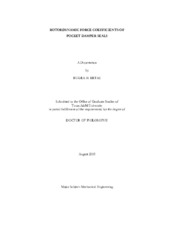| dc.description.abstract | The present work describes experiments conducted on several pocket damper seal
(PDS) designs using a high pressure annular gas seal test rig. Both rotating and non-rotating
tests were conducted for a 12, 8, and 6 bladed PDS. The objective of the tests was to
determine the rotordynamic force coefficients and leakage for the different PDS while
varying parameters such as: (1) clearance ratio, (2) rotor surface speed, (3) PDS pressure
differential, and (4) excitation frequency. Two different methods were used to determine
frequency dependent force coefficients: (1) the impedance method, which involved using a
baseline subtraction and (2) the dynamic pressure response method, which comprised of
measuring seal cavity dynamic pressure and phase relationship to vibration. Both methods
were used to determine coefficients, but the dynamic pressure response method revealed
insights to the dynamics of the PDS that were the first of its kind and allowed the comparison
to the damper seal theory at the most fundamental of levels. The results indicated that the
conventional PDS possessed high positive damping, negative and positive stiffness, and same
sign cross-coupled coefficients. Another objective of the work is to investigate a new fully
partitioned PDS design and accompany experimental results with the development of a
modified damper seal theory. The new fully partitioned PDS design was shown to give twice
as much damping as the conventional design and revealed the ability to modify direct stiffness
without degradation in direct damping. Finally, both the conventional theory and the newly
proposed theory predictions are compared to experimentally determined force coefficients.
The last objective was to evaluate the leakage characteristics of the different designs and to
investigate the effect of blade profile on seal leakage. Results showed that beveled tooth blade
profiles yield higher mass flow leakage compared to rectangular blade profiles. | en |


